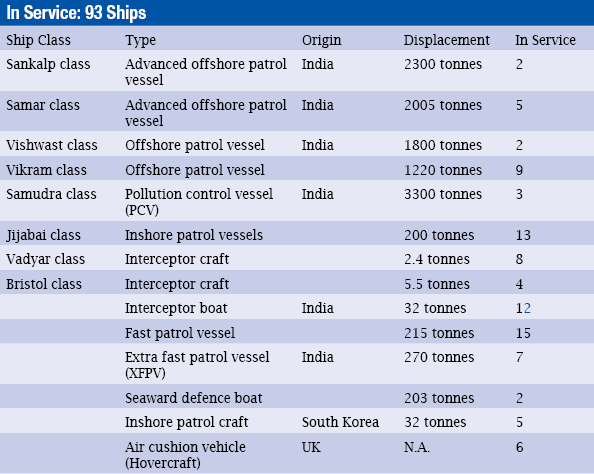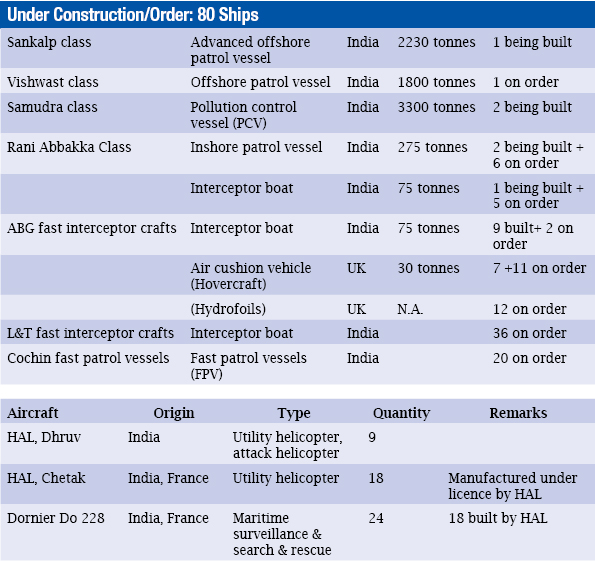INDIAN ARMED FORCES CHIEFS ON
OUR RELENTLESS AND FOCUSED PUBLISHING EFFORTS

SP Guide Publications puts forth a well compiled articulation of issues, pursuits and accomplishments of the Indian Army, over the years

I am confident that SP Guide Publications would continue to inform, inspire and influence.

My compliments to SP Guide Publications for informative and credible reportage on contemporary aerospace issues over the past six decades.
Coast Guard
Indian Coast Guard – Modernisation
With target set to triple its surface fleet strength and nearly doubling its Air Wing inventory, the Indian Coast Guard is well poised for a quantum jump in its coastal security prowess
ICG was formally established on August 18, 1978, as an armed force of the Union by the Coast Guard Act, 1978. It operates under the Department of Defence of the Union Ministry of Defence. The Coast Guard works in close cooperation with the Indian Navy, Department of Fisheries, Department of Revenue (Customs) and the Central and State police forces. The Coast Guard is the principal agency for enforcement of provisions of all national enactment in force in the Maritime Zones of India (MZI) and provides following services to the nation and marine community.
- Ensuring safety and protection of the artificial islands, offshore installations and other structure in India’s maritime zones.
- Providing protection to fishermen and assistance to them at sea while in distress.
- Preservation and protection of maritime environment including prevention and control of maritime pollution.
- Assistance to the Department of Custom and other authorities in anti-smuggling operations.
- Enforcement of MZI Acts.
- Initiating measures for the safety of life and property at sea.
The following additional responsibilities have been entrusted to the Indian Coast Guard:
- Coordinating authority for taking measures to address oil pollution response in the maritime zones of India. The Director General ICG is the Chairman of the National Oil Spill Disaster Contingency Plan preparedness meeting.
- The authority for coordinating maritime search and rescue in the Indian search and rescue region. The Chairman of the National Maritime Search and Rescue Board.
- The Chairman of the Offshore Security Coordination Committee and regular meetings are conducted at the national level to identify threats to offshore installations such as internal sabotage, terrorist attacks, hijacking of platforms, drill ships, jack up rig, blow outs, fire hazards, etc.
- The authority responsible for coastal security in territorial waters.
- Nominated as the Lead Intelligence Agency for the country’s coastal/sea borders—for the purpose of generating, coordinating and sharing the intelligence with the agencies concerned including the Central Government.
After the 2008 Mumbai attacks, the Indian Government initiated a programme to expand the ICG force, assets and infrastructure. The force is expected to be tripled by the end of the second decade of the century in terms of manpower, vessels and aircraft inventories.


Modernisation Plan
With target set to triple its surface fleet strength by the turn of this decade, ICG has placed orders for 131 surveillance platforms that are already under construction in Indian shipyards and is in the process of signing contracts for building another 200 platforms; as per official reports of MoD.
At present, the coast guard has 44 ships, six hovercraft, 28 Dornier coastal surveillance aircraft, four twin-engine Dhruv advanced light helicopters, 20 Chetak single-engine helicopters and 24 interceptor boats in its surface and air fleet. About 50 per cent of the surface platforms have already exceeded their designated life.
At present, the coast guard has 44 ships, six hovercraft, 28 Dornier coastal surveillance aircraft, four twin-engine Dhruv advanced light helicopters, 20 Chetak single-engine helicopters and 24 interceptor boats in its surface and air fleet. About 50 per cent of the surface platforms have already exceeded their designated life.
In pursuance of its modernisation plans Griffon 8000TD, a hovercraft built in UK and having a top speed of 50 knots and armed with a remote operated machine gun, was commissioned as ICG ACV H-187 at Okha. Accordingly, surface and air assets are being acquired for strengthening the newly created Coast Guard stations and the Headquarters, proportionate infrastructure is being developed and trained manpower is being augmented to protect the nation from threats emanating from the sea.
Two more hovercrafts will be joining the Okha station. ACV H-187 is the seventh hovercraft and first in the class of 12 hovercrafts to be supplied by UK-based Griffon Hoverwork Ltd, a pioneer in the machine, which was conceived 40 years ago.
Air Wing of ICG
The need for a full fledged Air wing for ICG was felt right from the time of its inception. The first ICG aviation unit to be commissioned was 800 Sqn on May 22, 1982 with two Chetak helicopters at Goa.
The first fixed-wing squadron of Indian Coast Guard was commissioned with two Fokker Friendship (F-27) aircraft on July 30, 1983. These aircraft were taken on dry lease from Indian Airlines. These aircraft did a yeomen service to ICG through their tireless operation from Dum Dum Airport in maritime surveillance and search and rescue roles covering the entire Exclusive Economic Zone.
The first planned induction included 12 fixed-wing aircraft for coastal surveillance and six single engine helicopters to support ships at sea.
The first Dornier squadron was commissioned as 750 SQN (ICG) at Daman in Jan 1987.
The first full-fledged air station was commissioned at Daman on October 29, 1987. Since then the following air squadrons/flights have been inducted into the service and are located as shown below:
Fixed-Wing Squadrons
| 750 Sqn (ICG) | Daman |
| 700 Sqn (ICG) | Kolkata |
| 744 Sqn (ICG) | Chennai |
| 745 Sqn (ICG) | Port Blair |
| 747 Sqn (ICG) | Kochi |
| Dornier Flight | Porbander |
Rotary-Wing Squadrons
| 800 Sqn (ICG) | Goa |
| 841 Sqn (ICG) | Daman |
| 842 Sqn (ICG) | Mumbai |
| 848 Sqn (ICG) | Chennai |
| CTK Flt | Port Blair |
Advanced Light Helicopter
| 850 Sqn (ICG) | Porbander |
The Air wing inventory of the ICG is as follows:
Accordingly, the Indian Coast Guard has floated a global tender worth over $200 million to procure 16 light utility helicopters to be deployed on its ships to augment aerial patrol and surveillance, as also the search and rescue capabilities. It is now reported that acquisition of light utility helicopters will follow the ‘Make in India’ route.
For upgrading the surveillance capabilities, 12 Dornier aircraft from HAL were planned for induction in the Eleventh Five Year Plan at a cost of $320 million, of which four have been inducted already. In addition, the Coast Guard has issued fresh RFI for procuring six multi mission maritime patrol aircraft. The present status of the project is not known.





